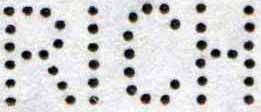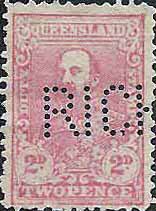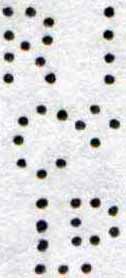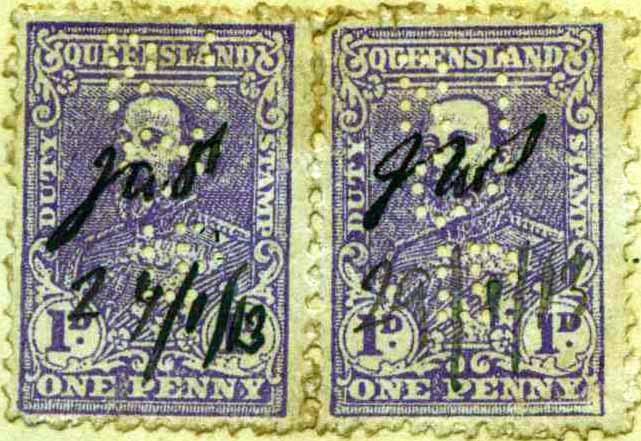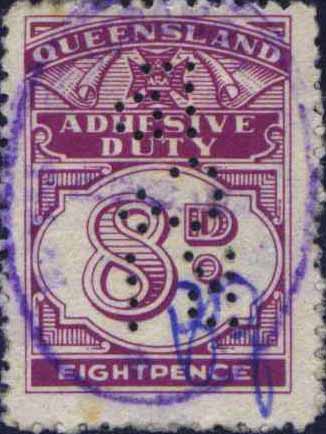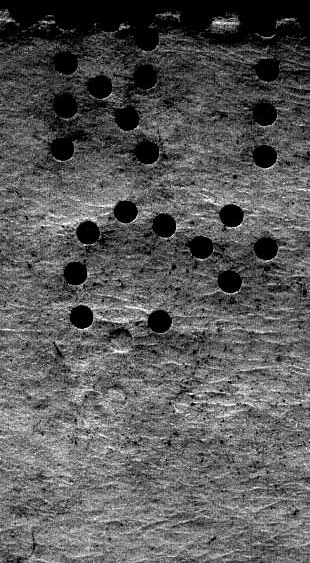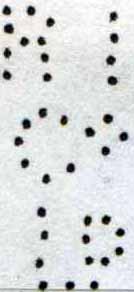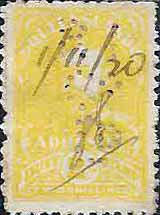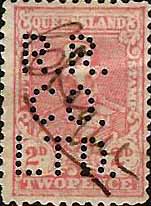|
Private Revenue Perfins of Queensland An Elsmore Coath production The authors would welcome your comments additions or input into this work
A B C E F G H I K L M N O P Q R S T V W Other R -------------------------------------------------------- RICH.a User: E H Rich & Co Ltd. Shipping Agents Address: Creek St, Brisbane, QLD Revenue Use: KEDVII 1901 issue 2d. Rarity Scale: KEDVII 1901 issue 2d R4. Background: E Rich and Company
Limited were formed in Brisbane in the 1890’s and
they were a trading company importing and on selling
goods. Their interests may have extended into port
facilities and coastal shipping as there Chairman
was at one time, Benjiman Macdonald, who was
instrumental in the development of coastal shipping
in Queensland and later formed the shipping company
Macdonald, Hamilton and Co, who were agents for
P&O until 1960. In 1924 E Rich took over the
business of the Queensland Agency Company but this
is about the time of the end of the use of the RICH
device so this may have been a contributing factor
to the discontinuance of the perforator. Device: The device is most likely a single head device and it is found in the characteristic variety of positions and angles of such devices. Approval to perforate stamps was sought and approved in February 1902 and the RICH pattern is found on revenue and postage stamps of Queensland and later postage stamps of Australia (from 1913) over the period 1902 until at least 1923. In late usage in the early 1920’s the pins at the bottom of the spine of the R are absent or blind indicating that the device was not in good working condition. Related Patterns: Nil -------------------------------------------------------- RI/Co/LD.a In 'I' of 'R I' the 'I' is to the right of the 'o' in Co on line two. User: Royal Insurance Co Ltd. General Insurance Provider Address: From 1959 359 Queen St, Brisbane, QLD Revenue Use: KEDVII 1908 issue 1d dated 1913, 3d, 6d, 1/-, 2/-, 2/6, 3/-, 5/-, 10/-, 20/-. KGV 1920 issue 1d, 2d, 4d, 1/-, 2/- dated 1924. Numeral 1930 issue 2d, 4d, 6d, 8d, 1/-. 1966 2c, 10c, 25c. Rarity Scale: KEDVII 1908 issue 1d R2, 3d R4, 6d R4, 1/- R4, 2/- R4, 2/6 R4, 3/- R4, 5/- R4, 10/- R4, 20/- R4. KGV 1920 issue 1d R5, 2d R4, 4d R5, 1/- R4, 2/- R4. Numeral 1930 issue 2d R2, 4d R4, 6d R4, 8d R4, 1/- R4. 1966 2c R3, 10c R3, 25c R4. Background: The Royal Insurance
Company was established in Liverpool in May 1845 and
expanded quickly into overseas markets establishing
offices in Australia, Canada, Singapore, and South
America by the 1850’s and later the US. By the 1860’s Royal had 10 offices
in Australia and it continued to grow through
mergers at home and abroad. In 1919 it acquired the
rival Liverpool & London and Globe Insurance
Company in what was, at the time the largest merger
in British Insurance history. This merger was a
trend that was to continue across the industry
through the 20th century culminating in Royals
merger with Sun Alliance, itself a product of
mergers between the Sun, Alliance, London and later
Phoenix Insurance companies. The resulting company Royal Sun
Alliance was formed in 1996 and was later (2008)
rebadged as RSA Insurance Group and is headquartered
in London. As part of these changes the companies
activities in Australia and New Zealand are
restructured under the Promina Brand and the General
Insurance arm is renamed Vero. Revised Qld Device for RI/CO/LD.a Device: In 1912 Royal Insurance
purchased a number of near identical devices for
their offices across Australia including Melbourne,
Sydney, Newcastle, Brisbane (this device), Adelaide
and Perth. From the evidence of multiple strikes it
is clear that these were a series of single head
devices. There may have been more than one device
for country offices in Queensland or larger offices
such as Melbourne and Sydney. Sydney is known to have used a
circa 1912 type RI/CO/LD device between 1912-1967,
as well as an RIC device between 1932-1967 and a
thicker pin variety of the RI/CO/LD in 1929-1930, so
there is evidence to support the theory of multiple
devices in the same location. Therefore it is
difficult to confirm how many of these circa 1912
devices there were as the patterns from the various
devices are so close. Some variation between the
patterns from these remote devices is noticeable but
is so subtle that it cannot be catalogued. It is worth considering the
possibility that the pattern was a result of a
single device, most likely located in the Melbourne
office, with punctured stamps then distributed to
the remote offices. However this is difficult to
support given the usage on postage and revenue
stamps of various States and the fact that the
Company subsequently purchased a similar (RI/CO/LD)
pattern device for the Hobart office in about 1930,
as well as providing a series of RI/CO devices to
the Launceston office between 1920 and 1969 and an
RIC device to the Sydney office from 1932-1967. If
you had a workable process from a central device
then these other devices would not be required. This RI/CO/LD device of Brisbane is
found on postage and revenue stamps of Queensland as
well as postage stamps of Australia for the period
from 1913. Usage on postage stamps for this pattern
is reported until as late as 1967. However due to
the similarities in the patterns produced by these
circa 1912 devices it is difficult to accurately
determine when a specific device in a particular
location stopped being used. Any closing date would
need to be supported by evidence based on issues
that the pattern is found on and postmark evidence.
In previous studies of this pattern
there have been a couple of small errors as follows: Report of an RI/CO pattern with an
RI/CO that is the same as the circa 1912 RI/CO/LD
pattern: This is most likely based on reports of partial strikes of the full circa 1912 RI/CO/LD pattern. We have seen many examples of these patterns and all show evidence of the top of the LD generally in blind pins or in some instances just the outline of part of the pin visible under a microscope.
Partial Strike [above] showing 2 blind pins for the top of LD. These partial strikes are not
common but they can be found on stamps of most
capital cities and over nearly the entire usage
period of the circa 1912 RI/CO/LD devices. Given
this broad usage and distribution and the fact that
they show evidence of the LD means that they are
most likely an operator error where insufficient
pressure is applied across the entire height of the
die head. The 1912 RI/CO/LD devices produce
patterns which are near to identical so defining
types is not possible. In previous studies the term
“type” has been used to describe a number of
different forms of variation within a pattern such
as, similar pattern images that may be the result of
alterations to the die head, a similar die of a
multi head device and the variation present in most
service punctures. Given that these circa 1912
RI/CO/LD devices were single head devices which
produced essentially identical strikes over the life
of the devices, the use of the term “type” is not
appropriate. The noting of these “types” may have been an attempt to describe the somewhat similar patterns such as RI/CO/LD.b, (detailed below) or the thicker pinned NSW pattern, RI/CO/LD.b (1929-30) of the Sydney office (see NSW listing) or indeed the Tasmanian RI/CO/LD.a (1930-63) of the Hobart office. (see Tasmanian listing). Related patterns: Refer to other
Royal Insurance patterns in: NSW: RIC.a RI/CO/LD.a
RI/CO/LD.b QLD: RI/CO/LD.b TAS: RI/CO.a RI/CO.b
RI/CO/LD.a WA: RI/CO/LD.a -------------------------------------------------------- RI/Co/LD.b The 'I' of 'R I' is now directly over the centre of the 'o' in Co on line two. User: Royal Insurance Co Ltd. General Insurance Provider Address: Unknown Revenue Use: KEDVII 1908 issue 20/-. KGV 1920 issue 2/-, 10/-. Rarity Scale: KEDVII 1908 issue 20/- R4. KGV 1920 issue 2/- R4, 10/- R4. Background: See RI/CO/LD.a Device: This is a previously unreported pattern and is only found on the revenue stamps of Queensland. It is similar in layout to the RI/CO/LD.a above but the leg of the R is less angled, the R and I are further apart and the L is distinctly larger. This device was short lived and usage centres around 1920. As outlined in RI/CO/LD.a above
there may have been more than one RI/CO/LD.a device
located in Queensland and this pattern may be the
result of a modification of one of these other .a
devices. If so it was not a successful modification
as the pattern tends to produce incomplete strikes
with poor pin penetration. Related patterns: Refer to other
Royal Insurance patterns in: NSW: RIC.a
RI/CO/LD.a RI/CO/LD.b QLD: RI/CO/LD.a TAS: RI/CO.a RI/CO.b
RI/CO/LD.a WA: RI/CO/LD.a -------------------------------------------------------- R.R./CO./LTD..a
User: Robert Reid & Co. Address: 144–148 Edward St, Brisbane, QLD Revenue Use: KEDVII 1908 issue 2d. Rarity Scale: KEDVII 1908 issue 2d R4. Background: Robert Reid was born in
Leven, Scotland, in 1842 and his family migrated to
Victoria in 1855. His father died soon after they
arrived and Robert, the eldest at just 13, had to
support his family. After working as a clerk he
spent 17 years with William Watson &
Sons,(wholesale warehouse), Swanston Street, before
starting his own wholesale drapery in Flinders Lane
in 1874, with partners Edward Warne and John Adair. In 1876 the company became Warne
& Reid and in 1881 they moved into new premises
with a staff of 90. The next year they established a
factory in Collingwood with 250 staff to manufacture
men's clothing, as well as opening a large Sydney
branch. In 1887 Warne retired and the company became
Robert Reid & Co. and by 1890 it was one
of the largest Australian importing businesses and
had additional branches in Adelaide and Brisbane, as
well as buying offices in London and Glasgow. In
1898 Reid's became a limited liability company with
a capital of £500,000 and its head office was
located in a five-storey building in London. Reid was elected to the Legislative
Council in 1892 and served until he resigned in
1903. In January 1903, Reid was elected to the
Senate but he did not seek re-election and he died
in May 1904 of complication of diabetes, while on
holiday in England. He was survived by his wife four
sons and six daughters. His sons continued the
family business and in 1966 Robert Reid & Co.
amalgamated with its long-time competitor Paterson,
Laing & Bruce to become Patterson, Reid &
Bruce. Device: The RR/CO/LTD device is a
single head device and is found in the usual range
of positions. It was the subject of an approval that
was granted in June 1911 and this date is supported
by postmark information. The pattern is found on postage and
revenue stamps of Queensland as well as Australian
stamps of the Commonwealth period up until 1923. Late usage shows the L almost entirely missing and it may have been this that lead to the discontinuance of the device. Related Patterns: Robert Reid are prolific perfin users in Victoria but these are all on postage stamps and to date none of the Robert Reid patterns of RR, RRC, RR&C, and RR&CO have been reported on revenue stamps of Victoria or other States. --------------------------------------------------------
A B C E F G H I K L M N O P Q R S T V W Other © copyright 2011 |
